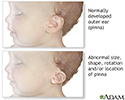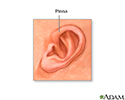Low-set ears and pinna abnormalities
Low-set ears; Microtia; "Lop" ear; Pinna abnormalities; Genetic defect-pinna; Congenital defect-pinna
Low-set ears and pinna abnormalities refer to an abnormal shape or position of the outer ear (pinna or auricle).
Considerations
The outer ear or "pinna" forms when the baby is growing in the mother's womb. The growth of this ear part takes place at a time when many other organs are developing (such as the kidneys). Abnormal changes in the shape or position of the pinna may be a sign that the baby also has other related problems.
Common abnormal findings include cysts in the pinna or skin tags .
Skin tags
A cutaneous skin tag is a common skin growth. Most of the time, it is harmless.

Many children are born with ears that stick out. Although people may comment on the ear shape, this condition is a variation of normal and is not linked with other disorders.
However, the following problems may be related to medical conditions:
- Abnormal folds or location of the pinna
- Low-set ears
- No opening to the ear canal
- No pinna
- No pinna and ear canal (anotia)
Causes
Common conditions that can cause low-set and unusually formed ears include:
- Down syndrome
-
Turner syndrome
Turner syndrome
Turner syndrome is a rare genetic condition in which a female does not have the usual pair of 2 X chromosomes.
Read Article Now Book Mark Article
Rare conditions that can cause low-set and malformed ears include:
-
Beckwith-Wiedemann syndrome
Beckwith-Wiedemann syndrome
Beckwith-Wiedemann syndrome is a growth disorder that causes large body size, large organs, and other symptoms. It is a congenital condition, which ...
 ImageRead Article Now Book Mark Article
ImageRead Article Now Book Mark Article -
Potter syndrome
Potter syndrome
Potter syndrome and Potter phenotype refers to a group of findings associated with a lack of amniotic fluid and kidney failure in an unborn infant....
 ImageRead Article Now Book Mark Article
ImageRead Article Now Book Mark Article -
Rubinstein-Taybi syndrome
Rubinstein-Taybi syndrome
Rubinstein-Taybi syndrome (RTS) is a genetic disease. It involves broad thumbs and toes, short stature, distinctive facial features, and varying deg...
 ImageRead Article Now Book Mark Article
ImageRead Article Now Book Mark Article - Smith-Lemli-Opitz syndrome
-
Treacher Collins syndrome
Treacher Collins syndrome
Treacher Collins syndrome is a condition that is passed down through families (hereditary). It leads to problems with the structure of the face....
Read Article Now Book Mark Article -
Trisomy 13
Trisomy 13
Trisomy 13 (also called Patau syndrome) is a genetic disorder in which a person has 3 copies of genetic material from chromosome 13, instead of the u...
 ImageRead Article Now Book Mark Article
ImageRead Article Now Book Mark Article -
Trisomy 18
Trisomy 18
Trisomy 18 is a genetic disorder in which a person has a third copy of material from chromosome 18, instead of the usual 2 copies.
 ImageRead Article Now Book Mark Article
ImageRead Article Now Book Mark Article
When to Contact a Medical Professional
In most cases, a health care provider finds pinna abnormalities during the first well-baby exam. This exam is most often done at the hospital at the time of delivery.
What to Expect at Your Office Visit
The provider will:
- Examine and test the child for other physical abnormalities of the kidneys, bones of the face, skull, and facial nerve
- Ask if you have a family history of abnormal-shaped ears
To determine whether the pinna is abnormal, the provider will take measurements with a tape measure. Other parts of the body will also be measured, including the eyes, hands, and feet.
All newborns should have a hearing test. Exams for any changes in mental development may be performed as the child grows. Genetic testing may also be done.
TREATMENT
Most of the time, no treatment is needed for pinna abnormalities because they do not affect hearing. However, sometimes cosmetic surgery is recommended.
- Skin tags may be tied off, unless there is cartilage in them. In that case, surgery is needed to remove them.
- Ears that stick out may be treated for cosmetic reasons. During the newborn period, a small framework may be attached using tape or Steri-Strips. The child wears this framework for several months. Surgery to correct the ears cannot be done until the child is 5 years old.
More severe abnormalities may require surgery for cosmetic reasons as well as for function. Surgery to create and attach a new ear is often done in stages.
References
Haddad J, Keesecker S. Congenital malformations. In: Kliegman RM, Stanton BF, St. Geme JW, Schor NF, eds. Nelson Textbook of Pediatrics . 20th ed. Philadelphia, PA: Elsevier; 2016:chap 638.
Parikh AS, Mitchell AL. Congenital anomalies. In: Martin RJ, Fanaroff AA, Walsh MC, eds. Fanaroff and Martin's Neonatal-Perinatal Medicine . 10th ed. Philadelphia, PA: Elsevier Mosby; 2015:chap 31.
-
Ear abnormalities - illustration
Low set ears (pinna), abnormal rotation, the absence of ears, and abnormal folds in the ear may be associated with various medical conditions.
Ear abnormalities
illustration
-
Pinna of the newborn ear - illustration
The pinna or auricle forms (during fetal development) at a time when many other critical organs are forming (such as the kidneys). Abnormalities in the shape or positioning of the pinna may be an indication that there are other associated abnormalities present.
Pinna of the newborn ear
illustration
-
Ear abnormalities - illustration
Low set ears (pinna), abnormal rotation, the absence of ears, and abnormal folds in the ear may be associated with various medical conditions.
Ear abnormalities
illustration
-
Pinna of the newborn ear - illustration
The pinna or auricle forms (during fetal development) at a time when many other critical organs are forming (such as the kidneys). Abnormalities in the shape or positioning of the pinna may be an indication that there are other associated abnormalities present.
Pinna of the newborn ear
illustration
Review Date: 11/19/2015
Reviewed By: Neil K. Kaneshiro, MD, MHA, Clinical Assistant Professor of Pediatrics, University of Washington School of Medicine, Seattle, WA. Also reviewed by David Zieve, MD, MHA, Isla Ogilvie, PhD, and the A.D.A.M. Editorial team.


